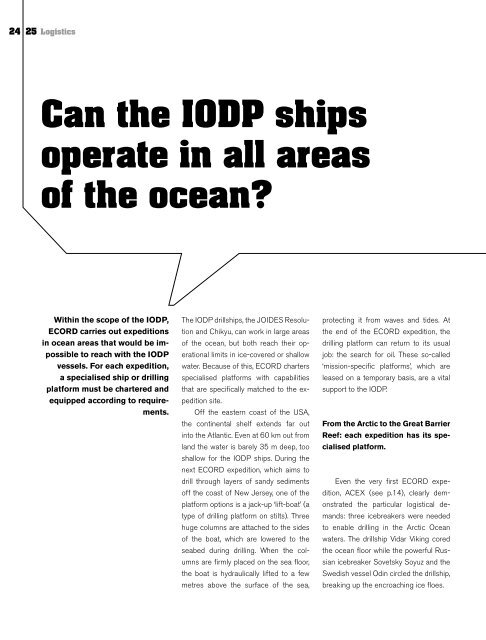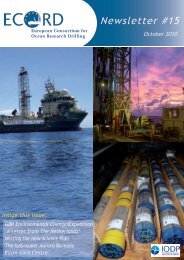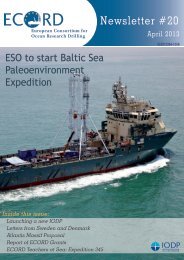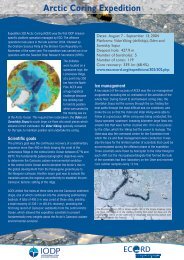printable version - European Consortium for Ocean Research Drilling
printable version - European Consortium for Ocean Research Drilling
printable version - European Consortium for Ocean Research Drilling
- No tags were found...
You also want an ePaper? Increase the reach of your titles
YUMPU automatically turns print PDFs into web optimized ePapers that Google loves.
24 25 LogisticsCan the IODP shipsoperate in all areasof the ocean?Within the scope of the IODP,ECORD carries out expeditionsin ocean areas that would be impossibleto reach with the IODPvessels. For each expedition,a specialised ship or drillingplat<strong>for</strong>m must be chartered andequipped according to requirements.The IODP drillships, the JOIDES Resolutionand Chikyu, can work in large areasof the ocean, but both reach their operationallimits in ice-covered or shallowwater. Because of this, ECORD chartersspecialised plat<strong>for</strong>ms with capabilitiesthat are specifically matched to the expeditionsite.Off the eastern coast of the USA,the continental shelf extends far outinto the Atlantic. Even at 60 km out fromland the water is barely 35 m deep, tooshallow <strong>for</strong> the IODP ships. During thenext ECORD expedition, which aims todrill through layers of sandy sedimentsoff the coast of New Jersey, one of theplat<strong>for</strong>m options is a jack-up ‘lift-boat’ (atype of drilling plat<strong>for</strong>m on stilts). Threehuge columns are attached to the sidesof the boat, which are lowered to theseabed during drilling. When the columnsare firmly placed on the sea floor,the boat is hydraulically lifted to a fewmetres above the surface of the sea,protecting it from waves and tides. Atthe end of the ECORD expedition, thedrilling plat<strong>for</strong>m can return to its usualjob: the search <strong>for</strong> oil. These so-called‘mission-specific plat<strong>for</strong>ms’, which areleased on a temporary basis, are a vitalsupport to the IODP.From the Arctic to the Great BarrierReef: each expedition has its specialisedplat<strong>for</strong>m.Even the very first ECORD expedition,ACEX (see p.14), clearly demonstratedthe particular logistical demands:three icebreakers were neededto enable drilling in the Arctic <strong>Ocean</strong>waters. The drillship Vidar Viking coredthe ocean floor while the powerful Russianicebreaker Sovetsky Soyuz and theSwedish vessel Odin circled the drillship,breaking up the encroaching ice floes.On the Tahiti Sea-Level Expedition (seep. 18), ECORD chartered the DP Hunter,a ship specialising in diving expeditions.As it already possessed an open shaft inthe middle of the ship, known as a moonpool,it was relatively straight<strong>for</strong>ward toconvert into a drillship with a mobile drillingderrick. A particularly precise positioningsystem allowed <strong>for</strong> an especiallycautious operation in close proximity tovulnerable, delicate coral reefs.ECORD scientists are involved inall IODP expeditions.As ECORD is one of the main playersin the IODP, scientists from the membercountries are able to take part in allIODP expeditions. For example, on leg315, one of the first of several plannedChikyu expeditions to the Nankai Trough,ECORD supplied one of the two expedi-tion chief scientists and nine of the 27scientists. Reciprocally, Japanese andUS researchers have taken part in expeditionsorganised by ECORD. This cooperationwith colleagues from aroundthe world makes IODP expeditionssomething special, according to biologistAnna Kaksonen of Tampere University inFinland. In December 2007, Kaksonenwas onboard the Chikyu: “There was areally international atmosphere, scientistsand crew from so many countries.The work was great fun, it was a uniqueexperience”, she said.







